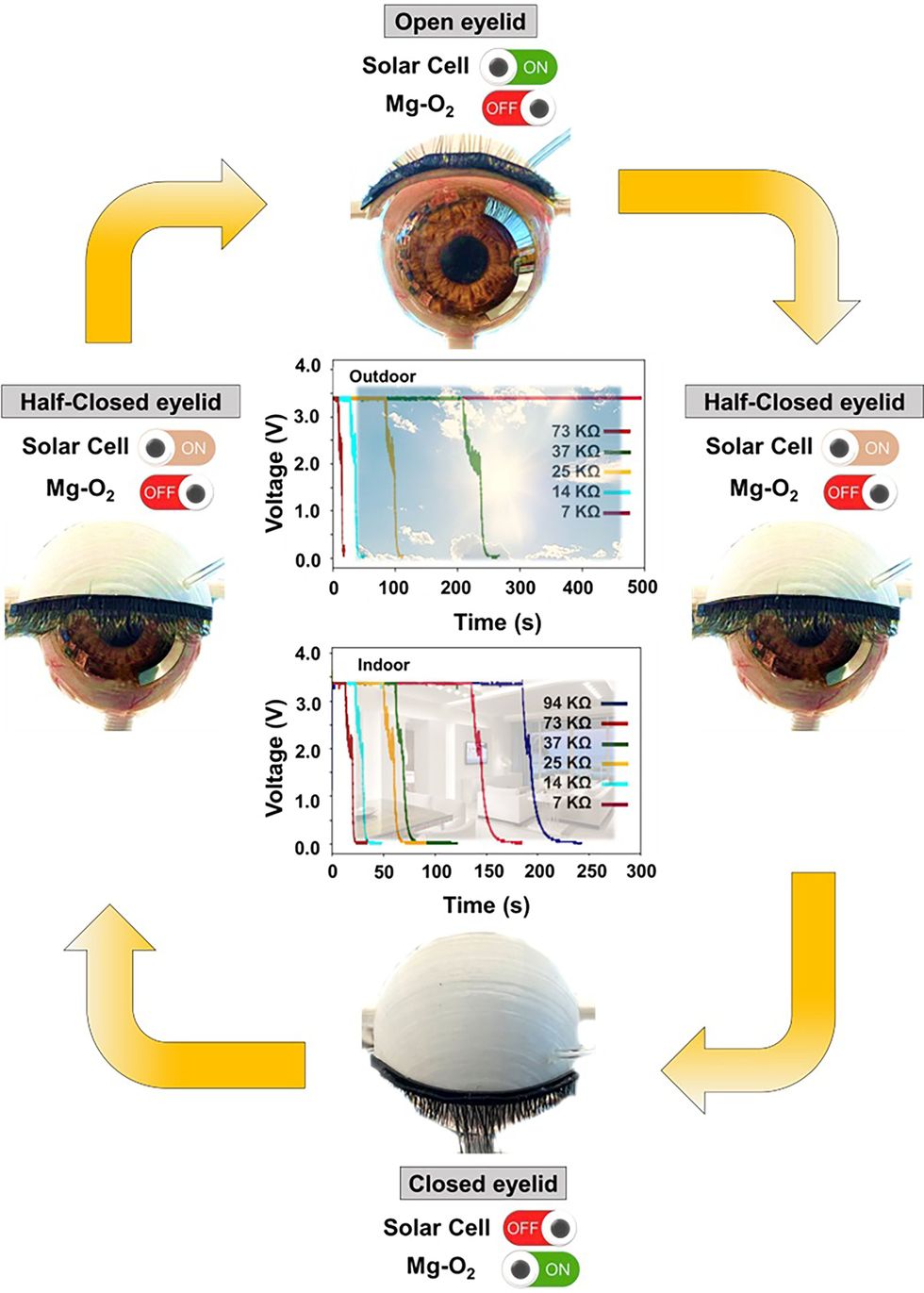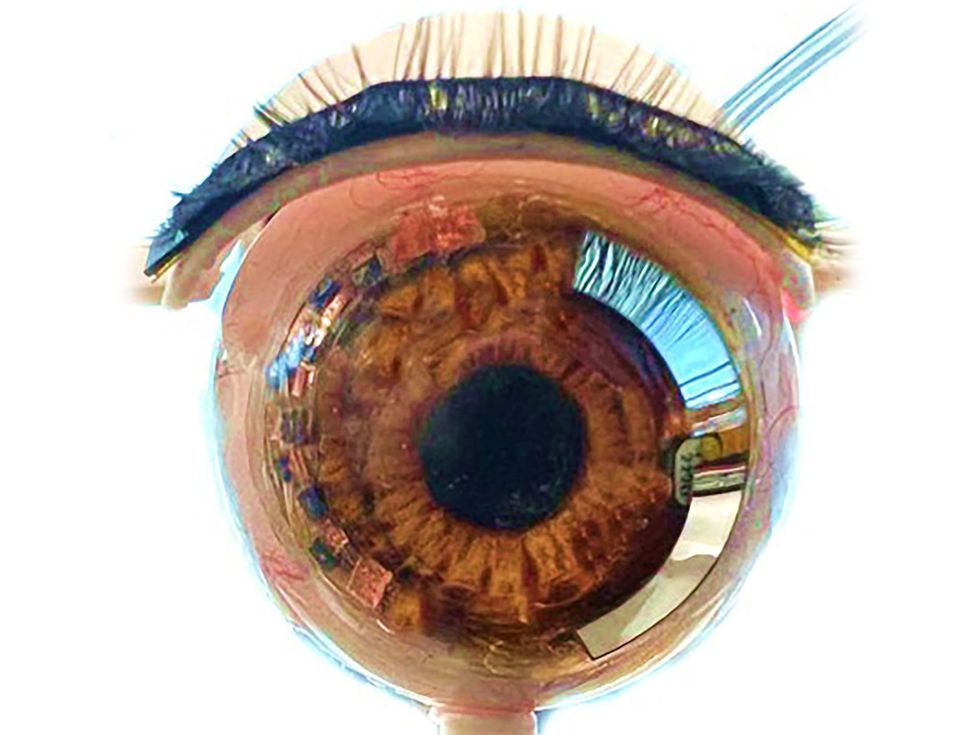The potential use cases for smart contacts are compelling and varied. Pop a lens on your eye and monitor health metrics like glucose levels; receive targeted drug delivery for ocular diseases; experience augmented reality and read news updates with displays of information literally in your face.
But the eye is quite a challenge for electronics design: With one of the highest nerve densities of any human tissue, the cornea is 300 to 600 times as sensitive as our skin. Researchers have developed small, flexible chips, but power sources have proved more difficult, as big batteries and wires clearly won’t do here. Existing applications offer less-than-ideal solutions like overnight induction charging and other designs that rely on some type of external battery.
Now, a team from the University of Utah says they’ve developed a better solution: an all-in-one hybrid energy-generation unit specifically designed for eye-based tech.
In a paper published in the journal Small on 13 March, the researchers describe how they built the device, combining a flexible silicon solar cell with a new device that converts tears to energy. The system can reliably supply enough electricity to operate smart contacts and other ocular devices.
This is a major improvement over wireless power transfer from separate batteries, says Erfan Pourshaban, who worked on the system while a doctoral student at University of Utah.
“Most current research includes a wireless power transfer with one antenna on the lens and another in a device that can be only about a centimeter away—a very, very tiny gap,” says Pourshaban, who is now a process-integration engineer at Texas Instruments. “It has to be right in your line of vision, which isn’t practical. We felt, if you can’t really wear it around, then it doesn’t matter if a smart contact’s actual technology is great. We’ve got to build a unit that can stand on its own.”
Photovoltaics and Metal-Air Batteries
To create the power pack, Pourshaban and his colleagues fabricated custom pieces. The first step was miniaturized, flexible silicon solar cells that can capture light from the sun as well as from artificial sources like lamps. The team connected eight tiny (1.5 by 1.5 by 0.1 millimeters) rigid crystalline cells and encapsulated them in a polymer to make a flexible photovoltaic system.
The second half is an eye-blinking-activated system that functions like a metal-air battery. The wearer’s natural tears—more specifically the electrolytes within them—serve as a biofuel to generate power.

The harvesting occurs literally in the blink of an eye: When the eye is completely open, the harvester is off. Then when the eye starts to blink, the tear electrolytes meet the magnesium anode, causing an oxidation reaction and the generation of electrons. Finally the tear electrolytes come into contact with both an anode and the platinum cathode, creating more energy through further oxidation on the surface of the anode and oxygen reduction on the surface of the cathode. The electrodes are kept from fouling by the motion of the eyelid and continual refreshing of the tears.
The two “halves” of this energy generation come together via a power-management circuit with an integrated 11-millifarad supercapacitor—which converts the voltages to DC, boosts them, and ultimately delivers about 150 microwatts of power at a stable 3.3 volts—no antennae, external battery pack, or special charging case required.
This system is “an exciting development in the realm of smart contact lenses,” says Wei Gao, a biosensors expert and assistant professor of medical engineering at Caltech, who was not involved in the research. He notes the promise of smart contacts has been hampered given that the “key hurdle for these devices is their need for a sustainable power source.”
This new power pack is not only “user friendly,” he notes, but also an “innovative dual-mode approach” that leverages two modes of energy harvesting so that it’s continuously happening—whether the eyes are open or closed.
“The reliable power output from this device can fuel a broad spectrum of applications, including wearable biosensors and electrically responsive drug-delivery systems, directly within the eye’s environment,” Gao adds.
Glaucoma and Other Applications
Pourshaban agrees, adding that there are obvious consumer applications, such as lenses that display to a runner the heart rate, pace, and calorie burn during a workout. Retailers could glean valuable insights from tracking how a shopper scans shelves and selects items. Commercialization potential is significant and varied, he says.
However, Pourshaban is perhaps most excited about potential applications in monitoring eye health, from prosaic conditions like presbyopia—age-related farsightedness, which can begin in the mid-40s—to more insidious diseases including glaucoma.
“Glaucoma is known as the silent thief of sight: There’s no pain, there may be nothing you notice, and then suddenly if the eye pressure gets to be too much in between your eye-doctor visits, you can irreversibly lose vision,” Pourshaban says. “If we could have real-time detection of warning signs for these and other conditions—and intervene quickly—it can change the course of a person’s life.”
- Mojo Vision Puts Its AR Contact Lens Into Its CEO's Eyes (Literally ... ›
- Smart Contact Lens Detects Diabetes and Glaucoma - IEEE Spectrum ›
- Smart Contact Lenses and Eye Implants Will Give Doctors Medical ... ›
- A Smart Contact Lens for Eye Injuries - IEEE Spectrum ›
Julianne Pepitone is a freelance journalist who reports via text, video, and television. She spent years on staff at CNN Business and then at NBC News, covering consumer tech, cybersecurity, and business. Now a freelancer, she works with an eclectic roster of clients. Beyond Spectrum, CNN, and NBC, her bylines can also be found at HGTV Magazine, Memorial Sloan Kettering, NYMag.com, Glassdoor, Popular Mechanics, Cosmopolitan, Town & Country, Thrillist, MagnifyMoney, The Village Voice, and more.



